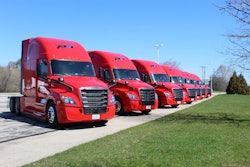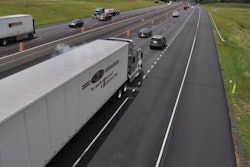The goal of a good spec for a targeted duty cycle is to achieve the most sought after results in any transportation environment. The first order of business is making sure the truck has the ability to carry a load with the least amount of energy required by the engine-driveline combination and the driver.
 Claude Ricciardi, director of purchasing, Transervice Logistics, Inc.
Claude Ricciardi, director of purchasing, Transervice Logistics, Inc.A properly spec’d vehicle will yield good fuel economy, reduce maintenance cost, minimize emergency breakdowns, provide driver satisfaction and be safe. Last, but not least, it will retain a good resale value at the end of its lifecycle.
Let’s take a component-by-component look at some spec’ing decisions.
Engine. Do you spec a 13 liter or 15 liter engine? If weight is a consideration and mileage is relatively low, a 13L engine would be more suitable. Smaller engines are good choices for applications like bulk haulers and regional haul applications. For line haul operations with high mileage, the 15L engine makes more sense since it is more robust than the smaller 13L. It also is able to develop more horsepower and torque making it an ideal solution for an owner-operator sleeper application.
Transmission. The take rate of 12 and 13 speed automated transmissions has grown exponentially over the past few years. They have many advantages over manual transmissions including providing improved fuel economy through correct shift points. They also reduce driver fatigue and aid in driver retention. However, there still may be some instances where a manual transmission is preferable, especially in vocational applications.
Rear axle ratios. Today’s engines are designed to run at low RPM at the intended cruise speed in top transmission gear, so it is very important to choose the correct ratio to keep the RPM within the manufacturer’s recommendation to achieve optimum performance and fuel economy. The percentage of miles driven on highway, percentage of grade, and the number of off-highway miles all have an impact on determining the correct rear axle ratios.
Tires. As in the selection of engine and driveline components, selecting the correct tire size will contribute to the correct engine RPM. In order to maximize tread life and retreadability, you need to consider tread design and casing construction. Low rolling resistance tires will be more fuel efficient, but may not be ideal in high scrub applications where a more aggressive tread and shoulder construction would be more suitable. Where weight is a consideration, the use of wide base tires is recommended.
Aerodynamics. There are many choices when it comes to aerodynamic devices ranging from full truck body packages to wheel covers. The choices can be overwhelming. In a line haul application, it may make sense to go all out with aero devices. However, in regional haul or a pickup and delivery operation, an air fairing and chassis fairing might be a more suitable choice.
Safety features. In recent years we have seen an explosion of advanced driver assist systems, including collision avoidance system, lane departure warning, electronic stability control and predictive cruise control. All of these have brought driver safety and reduction of accidents to a new level. Today, these features are almost standard and are highly recommended in any type of operation and duty cycle.
When it comes to spec’ing a vehicle, there is no one-size-fits-all answer. Matching the vehicle specs to its duty cycle and operating environment will yield the best results in fuel economy and durability and total cost of ownership.
Claude Ricciardi is the director of purchasing at Transervice Logistics, Inc., and manages all aspects of fleet equipment specification and creates, publishes and manages the RFP process. He also is responsible for the remarketing of off-lease equipment.













